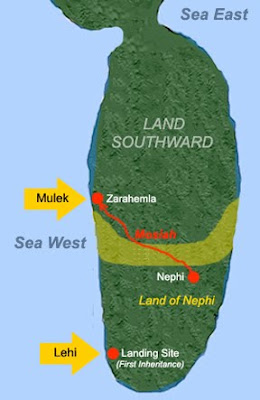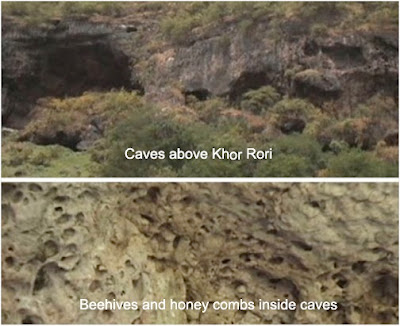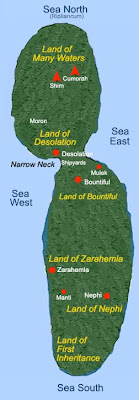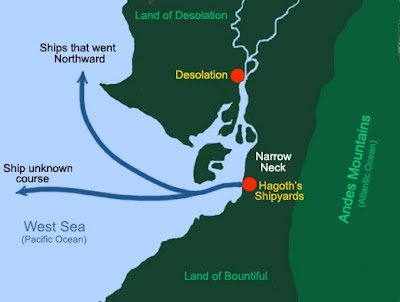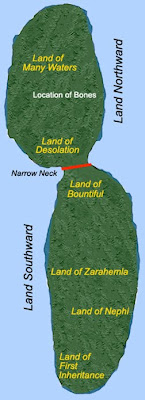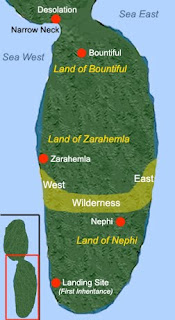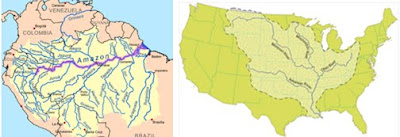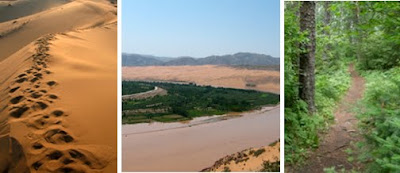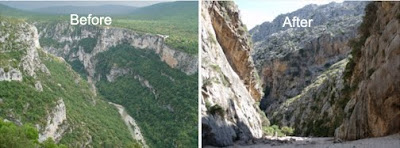 For some reason, he completely eliminates the Land Southward from any value regarding the Land of Promise. Perhaps we can take a couple of extremely important points here to show the fallacy of such a claim.
For some reason, he completely eliminates the Land Southward from any value regarding the Land of Promise. Perhaps we can take a couple of extremely important points here to show the fallacy of such a claim.First of all, Lehi was led into the Land South in the Land Southward. His landing site, or the area of First Inheritance, was along the West Sea south in the Land of Nephi (Alma 22:28). In fact, Mormon injects the following: “Now, the more idle part of the Lamanites lived in the wilderness, and dwelt in tents; and they were spread through the wilderness on the west, in the land of Nephi; yea, and also on the west of the land of Zarahemla, in the borders by the seashore, and on the west in the land of Nephi, in the place of their fathers' first inheritance, and thus bordering along by the seashore.”
Thus, Alma tells us 1) that Lehi landed in the Land Southward, 2) in the area later called the Land of Nephi, 3) “thus” or obviously, it was “along the seashore.” Now, just to make sure there is no mistake about where Lehi landed, we have “Now the land south was called Lehi and the land north was called Mulek, which was after the son of Zedekiah; for the Lord did bring Mulek into the land north, and Lehi into the land south” (Helaman 6:10).
Unquestionably, then, Lehi landed in the Land Southward. Now, of this land, Lehi said: “I know that I am a visionary man; for if I had not seen the things of God in a vision I should not have known the goodness of God, but had tarried at Jerusalem, and had perished with my brethren. But behold, I have obtained a land of promise, in the which things I do rejoice; yea, and I know that the Lord will deliver my sons out of the hands of Laban, and bring them down again unto us in the wilderness” (1 Nephi 5:4-5). Later, when blessing his children and grandchildren after landing, Lehi told them they had obtained the Land of Promise (2 Nephi 1:3,5), and told them how they should live in “this precious land of promise “ (2 Nephi 1:10), and that were it not for Nephi “who hath kept the commandments from the time that we left Jerusalem; and who hath been an instrument in the hands of God, in bringing us forth into the land of promise” (2 Nephi 1:24). Lehi also told them “Wherefore, I, Lehi, have obtained a promise, that inasmuch as those whom the Lord God shall bring out of the land of Jerusalem shall keep his commandments, they shall prosper upon the face of this land; and they shall be kept from all other nations, that they may possess this land unto themselves. And if it so be that they shall keep his commandments they shall be blessed upon the face of this land, and there shall be none to molest them, nor to take away the land of their inheritance; and they shall dwell safely forever” (2 Nephi 1:9).
And to Nephi the Lord said: “Blessed art thou, Nephi, because of thy faith, for thou hast sought me diligently, with lowliness of heart. And inasmuch as ye shall keep my commandments, ye shall prosper, and shall be led to a land of promise; yea, even a land which I have prepared for you; yea, a land which is choice above all other lands” (1 Nephi 2:19-20). Nephi was also shown a vision of the Land of Promise (1 Nephi 12:1,4,14,33) that they were to obtain, and calls the land toward which they were headed as the Land of Promise several times (1 Nephi 5:22; 7:11,13; 10:12). The Lord also told Nephi that He was leading them to the promised land (1 Nephi 17:13-14) and Nephi refers to the Land of Promise when they landed (1 Nephi 18:25). He also referred to it as the promised land on several occasions (1 Nephi 13:12; 14:2) and that they set sail for the promised land (1 Nephi 18:8,22) and that they landed on the promised land and that they called it the promised land (1 Nephi 18:22-23).
The problem is that the author of H38 claims that the Land Northward was all that mattered and was the land that held the promise. He quotes Moroni saying: “Ether truly told them of all things from the beginning of man and that after the waters had receded from off the face of this land it became a choice land above all other lands, a chosen land of the Lord” (Ether 13:2), but ignores the numerous references to the Land Southward also being so identified as shown in the cases above.
(See the next post, “Lehi’s Land of Promise Part II,” to see how Lehi’s Land of Promise encompassed the entire area of the Land Southward and the Land Northward)


